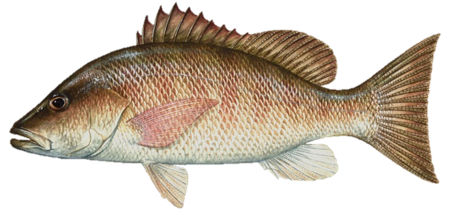
Scientific Name
Lutjanus griseus
Common Names
Mangrove snapper
Grey snapper
Mango
Stock Status
Overfishing – No
Overfished – No
Stock Assessment
Recreational Regulations
Federal Regulations
-
Open year-round
- 10 Bag Limit
- 10 Aggregate Limit
- Minimum Size: 12 in Total Length
Gear Description: Non-stainless steel circle hooks are required when fishing with natural baits. At least one dehooking device is required and must be used to remove hooks.
Notes: Anglers required to have a venting tool or descending device rigged and ready to use when fishing for reef fish species in Gulf of Mexico federal waters. For more information, see NOAA Descend Act.
To see commercial regulations, download Fish Rules Commercial App for iOS devices or Android devices.
Commercial Regulations
Harvest Limits
| Sector | Annual Catch Limit |
| Stock | 2,230,000 Pounds |
Additional Information
Description
Gray snapper, also called mangrove snapper or “mangoes,” are found throughout the Gulf of Mexico. They can vary in coloration, but are generally dark gray and brown on the upper half, with pink and orange coloration on the lower half of the fish. Their tail is broad and slightly forked. Males and females are largely indistinguishable from one another. Two stocks exist in the southeastern US: the Gulf of Mexico stock, and the Atlantic stock. The Gulf stock occupies the Gulf of Mexico east to approximately Biscayne Bay, near the Miami-Dade/Monroe County line in south Florida.
Maximum observed age: 32 years; 28 years1
Age at Maturity: 2 years2
Maximum weight: 48.83 lbs (22.15 kg) whole weight (West Florida/Alabama)3
Maximum length: ~35 inches (89 cm) FL4
Life History and Distribution
Gray snapper occur in tropical, subtropical and warm temperate waters from Brazil to Bermuda, and throughout the Gulf of Mexico and Caribbean Sea. Spawning occurs primarily in the summer months, between May and September. Gray snapper spend their first month of life in a larval phase, floating as plankton. As juveniles, gray snapper settle nearshore in estuaries, seagrass beds or shallow reefs, and gradually move offshore as they grow larger. Adults are often reef- or structure-associated5.
References
- SEDAR 51, Gulf of Mexico Gray Snapper Final Stock Assessment Report, April 2018.
- Farmer, N.A., Malinowski, R.P., McGovern, M.F. and Rubec, P.J. (2016), Stock Complexes for Fisheries Management in the Gulf of Mexico. Marine and Coastal Fisheries, 8: 177-201. doi:10.1080/19425120.2015.1024359
- SEDAR 51, Gulf of Mexico Gray Snapper Final Stock Assessment Report, April 2018.
- SEDAR 51, Gulf of Mexico Gray Snapper Final Stock Assessment Report, April 2018.
- SEDAR 51, Gulf of Mexico Gray Snapper Final Stock Assessment Report, April 2018.

